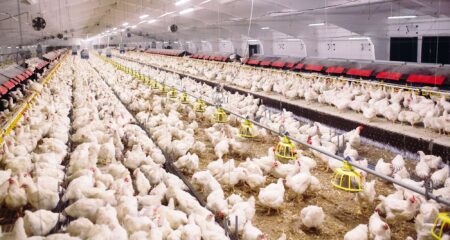The Trump administration’s removal of federal support for solar power, along with eliminating tax credits over the next three years, seems likely to cancel some projects, but industry experts insist that demand growth is too strong to stop solar entirely.
President Donald Trump has termed renewable energy a “green new scam” while promoting fossil fuels for energy dominance, and he got congressional Republicans to repeal Biden-era Inflation Reduction Act subsidies as part of a sweeping domestic policy bill enacted in July.
Meanwhile, USDA promised in March that solar panels on productive farmland would lose their prioritization points when seeking funding, and specifics arrived last month in a directive from J.R. Claeys, administrator of Rural Business Cooperative Services.
Rural Energy for America ground-mount solar projects are ineligible for loan guarantees and are disincentivized for priority points in seeking grants through August 2026.
The change may be moot since REAP is no longer accepting grant applications, although some farm groups want to revive it. Projects that won awards will continue to receive funding under terms in place at the time, USDA told Agri-Pulse.
The program is one of many sources of federal assistance soon to wither. But electricity demand is unlikely to abate, and solar may play a large role in meeting it.
“The One Big Beautiful Bill Act was tough, but constructive,” John Ketchum, chairman of NextEra Energy, said on a recent investor call, referring to the domestic policy law that repealed clean energy subsidies.
“Although there is more certainty with the passage of the bill, we will need to manage that against a backdrop of executive orders, agency rulemakings, tariffs and trade actions.”
NextEra, the biggest renewable energy provider in the U.S., added 1.7 gigawatts of solar to its backlog of projects in the second quarter.
Meanwhile, renewables were 3% of the generation capacity of Gulf Coast utility Entergy in 2024. The company recently said that solar will account for 17% of planned generation additions from now through 2029, both utility-owned and contracted through power purchases.
“The situation in the U.S. has been super fluid, but … the fundamentals of the market remain very strong,” said Catherine MacGregor, CEO of French multinational electric utility Engie. “The announcements that you’ve heard from hyperscalers on their capex [capital expenditure] spend in the coming weeks and coming months, it’s just spectacular.”
Hyperscalers are the large data centers that support artificial intelligence. The Electric Power Research Institute foresees them using up to 9.1% of U.S. power by 2030. Agri-Pulse research suggests they will use 4.7% of the nation’s electricity this year.
The consulting firm ICF expects U.S. electricity demand to grow 25% by 2030 and 78% by 2050. The Energy Department forecasts that solar production in 2050 will be more than five times today.
End of Tax Incentives
The Trump administration has affected solar mostly by changing the tax code in the One Big Beautiful Bill Act (H.R. 1).
Solar projects now must either begin construction before July 5, 2026, or be placed in service by Dec. 31, 2027, in order to qualify for the federal production tax credit or investment tax credit.
The former applies to the amount of electricity produced, while the latter applies to 30% of the cost of individual facilities. An entity cannot claim both credits for the same project. The in-service deadline for projects using the credits under the IRA was the end of 2032.
Entergy is among the utilities employing these credits, the value of which flows directly to customers, spokesman Neal Kirby said. Ratepayer benefit from the credits is a phrase commonly found in utility filings with the Securities and Exchange Commission.
“It’s the smaller, distributed systems of less than 10MW (megawatts) that will feel the impact of the lost credits most acutely,” said Ben Walker, vice president at consultancy Environ Energy. “For large projects, even though the costs are rising, the headwinds they face remain the same – the interconnection process where they get approval to connect to the grid is still the biggest hurdle for deployment of renewables.”
To enforce tax credit termination, the Treasury Department on Aug. 18 issued guidance that eliminates the safe harbor that said a 5% project spend constitutes the start of construction. For solar projects larger than 1.5 MW on or after Sept. 2, “physical work of a significant nature” is the sole indicator of the start of construction.
Ag accounting specialist Paul Neiffer says the new rules for the 2026 deadline are so complicated they will be difficult for farmers to meet.
Neiffer says in an advisory note that “for most farmers who want to put in a new solar or wind project, it will be much easier to qualify for the tax credit by simply getting the project done by December 31, 2027. Trying to qualify under the new safe harbor can be a rat’s nest to comply with.”
Abigail Ross Hopper, CEO of the Solar Energy Industries Association, said the guidance “is a blatant rejection of what Congress passed in H.R. 1.”
The new law also restricts manufactured products used in solar projects from foreign entities of concern, namely counties not allied with the U.S. or companies and individuals controlled by those countries. Too much foreign content disqualifies a project from the tax credits. Consultants said more guidance from Treasury is expected on the issue.
Even the smallest solar projects will soon lose their federal tax break, as H.R. 1 ends a 30% federal solar tax credit for homeowner installations made after 2025.
“Distributed solar, in particular, offers relief for rural communities and farm operations from commodity fuel markets,” said Erica Brinker, chief commercial and sustainability officer at developer Chaberton. Distributed solar comprises installations behind the utility meter that often serve a single house or farm.
Interior Department Scrutiny
An Aug. 1 order by the Interior Department said it shall only permit energy projects that are the most appropriate federal land use compared to reasonable alternatives that must be considered.
All department-related decisions and actions — comprising 69 categories — concerning wind and solar facilities will undergo “elevated review” by Interior Secretary Doug Burgum.
These announcements apply almost entirely to Western states where grazing rights may be at stake. The Trump administration has not shut down solar on federal lands entirely. Interior in April approved the Elisabeth Solar Project in Arizona. Two large projects in Nevada await department decisions, and two competing projects are under consideration on federal lands in western Colorado.
Can Gas Fill in When Tariffs Bite?
The Biden administration assisted U.S. solar panel manufacturing through grants, tax breaks and continued tariffs. But China still dominates the sector, and Chinese companies in recent decades have moved elsewhere in Asia, forcing U.S. regulators to start new antidumping and unfair trade practice investigations.
Trump’s ever-changing tariffs on China could affect U.S. solar capacity. If global tensions escalate, consultants McKinsey and Co. suggested that U.S. solar capacity will be clipped by 9% over 10 years compared with an outlook of “accelerated productivity.”
Independent of tariffs, the U.S. will generate more energy from natural gas in 2035 than it does today, according to McKinsey. The firm’s analysis also found that tariffs could make the proportion from gas “slightly larger.”
But the grid can’t rely entirely on natural gas for new generation. Scott Strazik, CEO of GE Vernova, reported a growing backlog for the gas turbines and other power equipment it manufactures at the end of the second quarter.
Investment adviser Lazard estimated that the levelized cost of energy for combined cycle gas generation ranges from $48/MWh to $109/MWh, “driven in part by recently observed market quotes … post-2028.”
For solar power, the investment tax credit results in a cost as low as $24/MWh (megawatt hours), Lazard said, while using the production tax credit brings it as low as $20/MWh. Without the credits, the levelized cost range for utility solar is $38-$78/MWh.
Consultants ICF and Rystad Energy have both foreseen solar taking market share from natural gas over the next 25 years, knocking gas generation to about 20% from the current 45%, while solar, barely at 10% now, becomes a quarter of the capacity.
This article was originally published by Agri-Pulse. Agri-Pulse is a trusted source in Washington, D.C., with the largest editorial team focused on food and farm policy coverage.


:max_bytes(150000):strip_icc()/IMG_1591-2048x1365-362687ca596f4814967abffff2b4be2c.jpg)
:max_bytes(150000):strip_icc()/SuccessfulFarmingShareImage-8fed6410b43147a19ed5ea1e3243227f.png)



:max_bytes(150000):strip_icc()/Solar-panels-USDA-23aa0cd2f1a04dbfa764674b0c2700cb.jpg)

:max_bytes(150000):strip_icc()/IMG_7575-ac6db3006a2145109bcc2df421c7a962.jpeg)

:max_bytes(150000):strip_icc()/Markets-3-Corn-up-3-19bdbeee0041452db8bce0a0f1c8b883.jpeg)